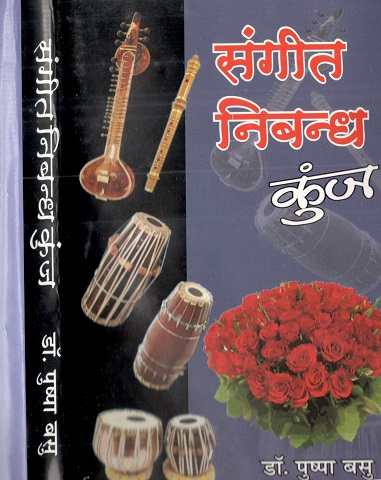Peep into the Book
Book Review: Sangeet Nibandh Kunj by Dr. Pushpa Basu

Peep into the BookBook Review: Sangeet Nibandh Kunj by Dr. Pushpa Basu |

|
By Dr. Ragini Trivedi |

Articles in a magazine or journal often present some novel, unexplored aspect of a given discipline, and are of interest to general readers. Books on other hand, deal with a subject thoroughly and in detail, demanding attention and patience on part of reader. The present volume manages to combine best of both.
Dr. Pushpa Basu, ever since her graduation has spent all her academic life at B.H.U., learning from the best and in her turn, teaching generations of committed students, granted admission to courses after rigorous selection process. Right from in-house journals, seminars to international conferences, Dr. Basu has been contributing to scholarship of Indian music since 1960’s. Her books, Rag Rupanjali in Hindi and Twentieth Century String Compositions in English, are in constant demand by string-players desirous of mastering Misrabani compositions. Dr. Basu, became an authority, writing her doctoral thesis on the string schools in Indian music. She continues her study of Sitar schools and to-date maintains interest in upcoming performers.
This book comes as a primer to anyone wishing to understand Indian music in general and Sitar in particular. It would be of great interest to international readers because of its matter-of-fact style without lengthy explanations, if language of the book is no impediment. The scholars from other discipline would appreciate the book because it is racy with a Dummies-style ease of reading. There are 33 essays in the volume. First eight give life-and-work account of prominent musicians and sitarists, from stalwart Pt. Paluskar, Pt. Bhatkhande to brilliant performer Dr. Gopalshankar Misra, in about four pages each. Two following essays place Indian music in Vedic ages and trace role of musical instruments in that period as per Natyashastra of Bharat.
She examines the evolution of musical string instruments; development of independent playing and significance of compositions in string-play. After tracing development of modern Sitar, she briefly notes prominent schools and elements of their styles; compares string playing with singing and other significant factors. She even tries to assess the contemporary style and future of strings. There are essays devoted to study, academics and curriculum.
The final few include tracing history of percussion instruments and development of Mridang and Tabla. Limiting it to Varanasi, she traces history of Tabla-playing and names even contemporary Tabla-players of Banaras Baj. She notes ten main points that make Banaras Baj distinct from other schools of Tabla. For example, Tabla playing starts with “Uthaan”.
As one speeds through the book, it is difficult to rid of the idea that at least some of the essays might have been written for journals. But the perfection with which they blend in granting continuity of thought, it is a credit to author for expressing things in segments that are complete by themselves. I would recommend this as a compulsory read for anyone wishing to pursue a music course at college level. Specially, for those who are not in direct touch with their teachers, this book would prove god-send.
Language: HindiOrder a copy of this book and browse for others here
Suggested:
Bharatiya Sangeet Vadya on wikipedia
Raga Vibodh: Misrabani Purchase on external site
Sitar Compositions in Ome Swarlipi Read Review by Pt. Omprakash Chaurasiya
Bhāratīya Shāstrīya Sangīt: Shāstra, Shikshan Va Prayōg
List of books on music.
Musical tracks.
Annotated compositions.